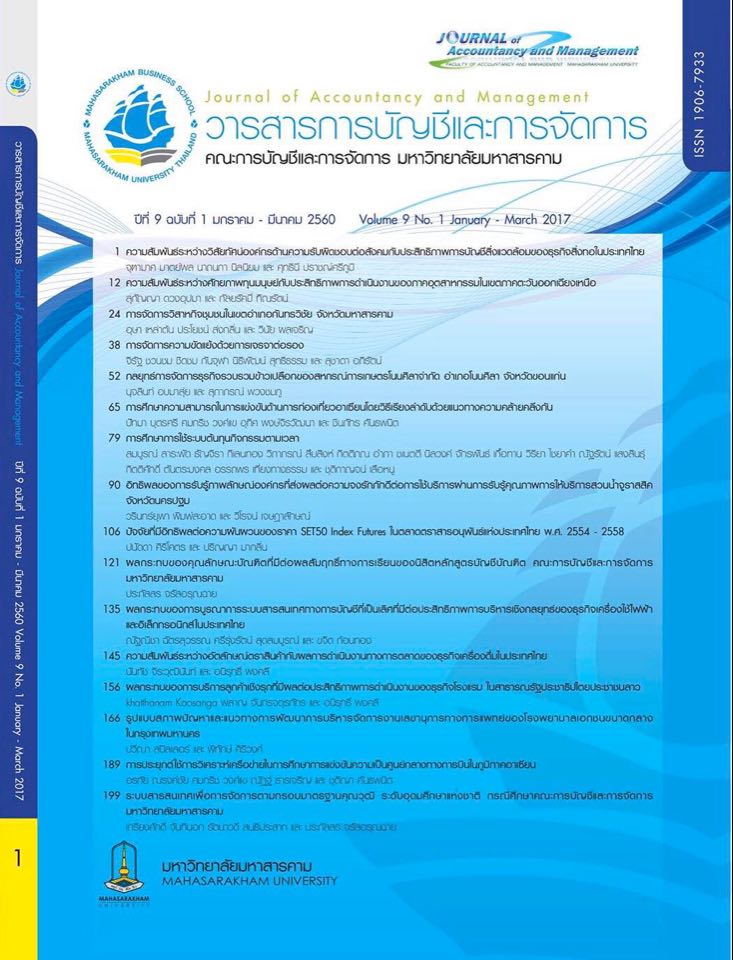การศึกษาความสามารถในการแข่งขันด้านการท่องเที่ยวอาเซียนโดยวิธีเรียงลำดับด้วยแนวทางความคล้ายคลึงกัน
Main Article Content
บทคัดย่อ
การท่องเที่ยวเป็นปัจจัยที่ส่งผลต่อการเจริญเติบโตทางเศรษฐกิจ การวิเคราะห์ความสามารถในการแข่งขันของกลุ่มประเทศที่มีทรัพยากรการท่องเที่ยวที่คล้ายคลึงกัน จะนำไปสู่นโยบายส่งเสริมความร่วมมือภายในภูมิภาค บทความนี้ใช้วิธีเรียงลำดับด้วยแนวทางความคล้ายคลึงกัน (Technique for Order Preference by Similarity to Ideal Solution: TOPSIS) ในการวิเคราะห์ความสามารถในการแข่งขันด้านการท่องเที่ยวของประเทศอาเซียน 10 ประเทศ โดยใช้ดัชนีชี้วัด 9 ตัวชี้วัดหลัก และ 51 ตัวชี้วัดย่อย และใช้ข้อมูลจำนวนทรัพยากรการท่องเที่ยวที่ได้รับการจัดอันดับจากเว็บไซต์ท่องเที่ยว และจำนวนแหล่งท่องเที่ยวที่ได้รับรางวัล Travellers’ choice จากเว็บไซต์ TripAdvisor ผลการศึกษาพบว่าประเทศต่างๆ มีความสามารถในการแข่งขันแต่ละตัวชี้วัดที่แตกต่างกัน ประเทศที่มีความสามารถในการแข่งขันรวมสูงสุด 5 อันดับแรกได้แก่ ฟิลิปปินส์ ไทย มาเลเซีย อินโดนีเซีย และเวียดนามตามลำดับ จากผลการศึกษาสามารถนำไปเสนอแนะเส้นทางการท่องเที่ยว เพื่อเจาะกลุ่มเป้าหมายที่เป็นนักท่องเที่ยวเฉพาะกลุ่ม นอกจากนี้ยังสามารถเสนอแนะให้สร้างความร่วมมือสำหรับกลุ่มประเทศที่มีความสามารถในการแข่งขันที่คล้ายคลึงกัน รวมทั้งเป็นแนวทางในการส่งเสริมการท่องเที่ยวสำหรับประเทศที่มีความสามารถในการแข่งขันน้อยกว่าประเทศเพื่อนบ้าน
Downloads
Article Details
บทความที่ได้รับการตีพิมพ์เป็นลิขสิทธิ์ของวารสารการบัญชีและการจัดการ
ข้อความที่ปรากฏในบทความแต่ละเรื่องในวารสารวิชาการเล่มนี้เป็นความคิดเห็นส่วนตัวของผู้เขียนแต่ละท่านไม่เกี่ยวข้องกับมหาวิทยาลัยมหาสารคาม และคณาจารย์ท่านอื่นๆในมหาวิทยาลัยฯ แต่อย่างใด ความรับผิดชอบองค์ประกอบทั้งหมดของบทความแต่ละเรื่องเป็นของผู้เขียนแต่ละท่าน หากมีความผิดพลาดใดๆ ผู้เขียนแต่ละท่านจะรับผิดชอบบทความของตนเองแต่ผู้เดียว
เอกสารอ้างอิง
กนกพรรณ นวลงาม. (2558). ผลกระทบของศักยภาพการตอบสนองลูกค้าที่มีต่อผลการดำเนินงานของธุรกิจโรงแรมในภาคเหนือ. วารสารการบัญชีและการจัดการ, 7(1), 11.
Alexandrakis, G., Manasakis, C., & Kampanis, N. A. (2015). Valuating the effects of beach erosion to tourism revenue. A management perspective. Ocean & Coastal Management, 111, 1-11.
Au, N., Buhalis, D., & Law, R. (2014). Online complaining behavior in Mainland China hotels: the perception of Chinese and non-Chinese customers. International Journal of Hospitality & Tourism Administration, 15(3), 248-274.
Banerjee, S., & Chua, A. Y. (2016). In search of patterns among travellers' hotel ratings in TripAdvisor. Tourism Management, 53, 125-131.
Chaney, S., & Ryan, C. (2012). Analyzing the evolution of Singapore's World Gourmet Summit: An example of gastronomic tourism. International journal of hospitality management, 31(2), 309-318.
Chanin, O., Khunchumnan, P., Amphansookko, S., Thongyai, K., Rodneum, J., & Sriprasert, P. (2015). Guidelines on health tourism management for middle eastern tourists in phuket province. Procedia Computer Science, 65, 1146-1153.
Cirstea, S. D. (2014). Travel &Tourism Competitiveness: A study of World's top economic Competitive countries. Procedia Economics and Finance, 15, 1273-1280.
Cunha, S. K. D., & Cunha, J. C. D. (2005). Tourism cluster competitiveness and sustainability: proposal for a systemic model to measure the impact of tourism on local development. BAR-Brazilian Administration Review, 2(2), 47-62.
Ding, L., & Zeng, Y. (2015). Evaluation of Chinese higher education by TOPSIS and IEW—The case of 68 universities belonging to the Ministry of Education in China. China Economic Review, 36, 341-358.
Evans, N. G. (2016). Sustainable competitive advantage in tourism organizations: A strategic model applying service dominant logic and tourism's defining characteristics. Tourism Management Perspectives, 18, 14-25.
Fundeanu, D. D. (2015). Innovative regional cluster, model of tourism development. Procedia Economics and Finance, 23, 744-749.
Filieri, R. (2015). Why do travelers trust TripAdvisor? Antecedents of trust towards consumer-generated media and its influence on recommendation adoption and word of mouth. Tourism Management, 51, 174-185.
Forsyth, P., King, J., & Rodolfo, C. L. (2006). Open skies in ASEAN. Journal of Air Transport Management, 12(3), 143-152.
Hanaoka, S., Takebayashi, M., Ishikura, T., & Saraswati, B. (2014). Low-cost carriers versus full service carriers in ASEAN: The impact of liberalization policy on competition. Journal of Air Transport Management, 40, 96-105.
Jeacle, I., & Carter, C. (2011). In TripAdvisor we trust: Rankings, calculative regimes and abstract systems. Accounting, Organizations and Society, 36(4), 293-309.
Kadir, N., Nayan, S., & Abdullah, M. S. (2013). A panel data analysis of international tourist arrivals from ASEAN countries to Malaysia. Procedia Economics and Finance, 7, 80-85.
Kladou, S., & Mavragani, E. (2015). Assessing destination image: An online marketing approach and the case of TripAdvisor. Journal of Destination Marketing & Management, 4(3), 187-193.
Lee, H. K., & Fernando, Y. (2015). The antecedents and outcomes of the medical tourism supply chain. Tourism Management, 46, 148-157.
Tewari, P. C., Prakash, U., & Khanduja, D. (2015). Ranking of sintered material for high loaded automobile application by applying entropy-TOPSIS method. Materials Today: Proceedings, 2(4), 2375-2379.
Tiago, T., Amaral, F., & Tiago, F. (2015). The good, the bad and the ugly: Food quality in UGC. Procedia-Social and Behavioral Sciences, 175, 162-169.
Weidenfeld, A. (2013). Tourism and cross border regional innovation systems. Annals of Tourism Research, 42, 191-213.
Wong, E. P., Mistilis, N., & Dwyer, L. (2011). A model of Asean collaboration in tourism. Annals of Tourism Research, 38(3), 882-899.
Yoon, K., & Hwang, C.L. (1980). Multiple attribute decision making methods and applications. A state of the art survey. Berlin: Springer Verlag.
Zhang, H., Gu, C. L., Gu, L. W., & Zhang, Y. (2011). The evaluation of tourism destination
competitiveness by TOPSIS & information entropy–A case in the Yangtze River Delta of China. Tourism Management, 32(2), 443-451.
Zhao, J., & Fang, Z. (2016). Research on campus bike path planning scheme evaluation based on TOPSIS method: Wei'shui campus bike path planning as an example. Procedia Engineering, 137, 858-866.


